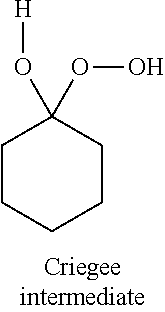Method for manufacturing ester
a technology of ester and cyclohexanone, which is applied in the direction of organic oxidation, chemistry apparatus and processes, organic chemistry, etc., can solve the problems of low yield of -caprolactone obtained from cyclohexanone, high toxicity of organic selenium reagent used as catalyst, and poor selectivity of functional groups, etc., to achieve excellent catalytic activity and high yield
- Summary
- Abstract
- Description
- Claims
- Application Information
AI Technical Summary
Benefits of technology
Problems solved by technology
Method used
Image
Examples
examples
[0029]In the following Examples and Comparative Examples, 1H NMR spectrum was measured by an ECS-400 (400 MHz) spectrometer manufactured by JEOL, and 13C NMR spectrum was measured by an ECS-400 (100 MHz) spectrometer manufactured by JEOL. The progress of reaction was monitored by thin-layer chromatography (TLC) using a precoated TLC plate (silica gel 60 GF254, 0.25 mm) manufactured by Merck. As solvents and reagents for the reaction, commercially available products were used without any additional treatment.
Reference Example
[0030]Borate salts functioning as catalysts used in the following Examples and Comparative Examples will be described. As NaB(3,5-CF3C6H3)4, LiB(C6F5)4, and Ph3CB(C6F5)4, commercially available products were used for the reaction without any additional treatment. LiB(3,5-CF3C6H3)4 and KB(3,5-CF3C6H3)4 were synthesized in accordance with methods described in the literature (Organomet., 1992, vol. 11, p 3920).
[0031]Sr[B(3,5-CF3C6H3)4]2.10H2O was synthesized as desc...
examples 12 to 23
, Comparative Examples 3 to 6
[0048]As shown in Table 2, in Examples 12 to 23, an ε-caprolactone corresponding to commercially available 4-tert-butylcyclohexanone was manufactured with various borate salts functioning as the catalyst by a Baeyer-Villiger oxidation reaction using hydrogen peroxide. The catalyst was not used in Comparative Example 3, NaBF4, NaBPh4, and LiNTf2 were used as the catalysts in Comparative Examples 4 to 6, respectively, and the same ε-caprolactone as described above was manufactured in a manner similar to that described above. In the above Examples and Comparative Examples, the catalysts and reaction conditions shown in Table 2 were used, and the reaction was carried out in accordance with that in Example 4. In addition, in this reaction, besides the ε-caprolactone, a spiro-bisperoxide was also produced. In Table 2, the conversion rate from the cyclohexanone to the reaction products and the yield of each product are shown. In addition, the conversion rate an...
examples 24 to
[0056]In Examples 24 to 30, as shown in Chem. 1, lactones were synthesized from various cyclic ketones by a Baeyer-Villiger oxidation reaction using hydrogen peroxide. In Example 24, when 2-methylcyclohexanone, which was an asymmetric cyclic ketone, was used, a corresponding ε-caprolactone was obtained at a high yield with normal regioselectivity. In Example 25, when 4-isopropenylcyclohexanone, which was a cyclic ketone having a substituent with an olefinic bond, was used, a corresponding ε-caprolactone was obtained at a yield of 56%, and no epoxidation of the olefin was observed. In Example 26, when 4-hydroxycyclohexanone was used, a five-membered lactone having a hydroxyethyl group was obtained. In this case, it is construed that after a corresponding ε-caprolactone was formed, this lactone was obtained by rearrangement therefrom into a five-membered ring having a smaller ring strain. In Examples 27 to 29, when a five-membered ring ketone and a four-membered ring ketone were used,...
PUM
| Property | Measurement | Unit |
|---|---|---|
| temperature | aaaaa | aaaaa |
| temperature | aaaaa | aaaaa |
| temperature | aaaaa | aaaaa |
Abstract
Description
Claims
Application Information
 Login to View More
Login to View More - R&D
- Intellectual Property
- Life Sciences
- Materials
- Tech Scout
- Unparalleled Data Quality
- Higher Quality Content
- 60% Fewer Hallucinations
Browse by: Latest US Patents, China's latest patents, Technical Efficacy Thesaurus, Application Domain, Technology Topic, Popular Technical Reports.
© 2025 PatSnap. All rights reserved.Legal|Privacy policy|Modern Slavery Act Transparency Statement|Sitemap|About US| Contact US: help@patsnap.com



